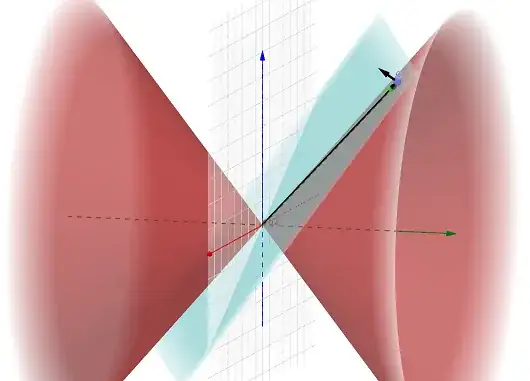Assume without loss of generality that $v$ is a unit vector.
Let $n$ be the unit vector normal to the sought plane, with non-negative $n_y$.
The angle between $n$ and the y axis is equal to the angle between the sought plane and the XZ plane:
$\cos(i) = n\cdot \left[ {\begin{array}{c}
0 \\
1 \\
0
\end{array} } \right]\Rightarrow n_y=\cos(i).$
The vectors $n$ and $v$ are orthogonal:
$n\cdot v=0\Rightarrow n_x=\frac{- n_{y} v_{y} - n_{z} v_{z}}{v_{x}}$
The vector $n$ is a unit vector:
$n_{x}^{2} + n_{y}^{2} + n_{z}^{2} = 1\Rightarrow n_{z1,2}=\pm \sqrt{1-n_x^2 - n_y^2}$
Inserting $n_{z1}$ in the solution for $n_x$ yields:
$$\begin{align}n_x&=\frac{- n_{y} v_{y} + v_{z} \sqrt{- n_{x}^{2} - n_{y}^{2} + 1}}{v_{x}}\\\Rightarrow n_{x1,2}&=\frac{- n_{y} v_{x} v_{y} \pm v_{z} \sqrt{- n_{y}^{2} v_{x}^{2} - n_{y}^{2} v_{y}^{2} - n_{y}^{2} v_{z}^{2} + v_{x}^{2} + v_{z}^{2}}}{v_{x}^{2} + v_{z}^{2}}\end{align}$$
Inserting $n_{x1,2}$ into $n_{z1}$ yields two solutions for $n_z$, which shall be referred to as $n_{z11}$ and $n_{z12}.$
Inserting $n_{z2}$ into the solution for $n_x$ yields the same $n_{x1,2}$, which inserted into $n_{z2}$ yield $n_{z21}$ and $n_{z22}$.
In total there are four solutions:
$$\left[ {\begin{array}{c}
n_{x1} \\
n_y \\
n_{z11}
\end{array} } \right],\left[ {\begin{array}{c}
n_{x2} \\
n_y \\
n_{z12}
\end{array} } \right],\left[ {\begin{array}{c}
n_{x1} \\
n_y \\
n_{z21}
\end{array} } \right],\left[ {\begin{array}{c}
n_{x2} \\
n_y \\
n_{z22}
\end{array} } \right],$$
of which one is hopefully sound.
As for the constraint with regards to the angle $\theta$ and vector $r$: I think now that it is irrelevant. For any angle $\theta$ and vector $v$ in a plane there are an infinite number of vectors with angle $\theta$ relative to $v$ in that plane.
